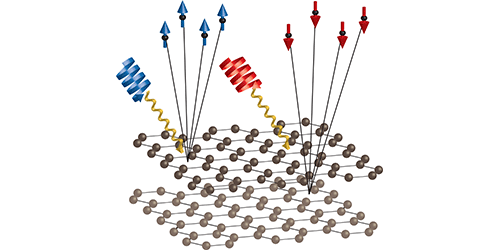Revealing a Hidden Spin Polarization
The layers inside certain materials can carry spin-polarized electrons, but this polarization is hidden to measurements that aren’t sufficiently localized. A new study using photoemission spectroscopy has detected the hidden spin polarization in a graphene-like material called molybdenum disulfide (MoS ). Unique to this work is the ability to target specific populations of spin-polarized electrons with circularly polarized light.
Polarized spins, which can be programmed to carry information, are traditionally produced with magnetic fields. However, researchers are actively exploring nonmagnetic methods that could prove faster and more versatile for processing spin information. So-called transition-metal dichalcogenides (TMDCs), which include MoS , are nonmagnetic materials whose layers exhibit a crystal asymmetry that produces spin polarization. But the polarization is hidden because the polarization direction is opposite for adjacent layers, resulting in a net polarization of zero.
Previous work observed hidden spin polarization in a TMDC called tungsten diselenide by targeting the surface layer of the material (where the spin polarization points “up” out of the surface). Now, Elia Razzoli of the University of Fribourg, Switzerland, and his colleagues have demonstrated a way to probe the spin polarization of deeper layers. In their spin- and angle-resolved photoemission spectroscopy experiments with MoS , circularly polarized photons with energy around 50 eV penetrated into the material, causing electrons to be ejected. The spins of these electrons depended on the polarization of the light. In agreement with this observation, the team’s calculations showed that left-handed (right-handed) light preferentially excites spin-up (spin-down) electrons in different layers of MoS . The results suggest the possibility of devices in which polarized light selects and manipulates different spin populations within a bulk material.
This research is published in Physical Review Letters.
–Michael Schirber
Michael Schirber is a Corresponding Editor for Physics based in Lyon, France





